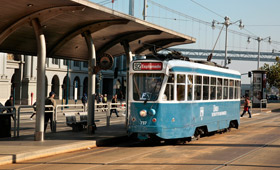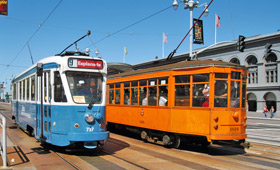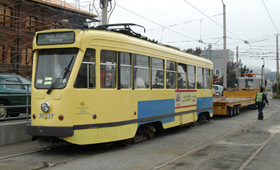The Presidents’ Conference Committee (PCC) streetcar was a distinctly American invention, dreamed up by a group of transit company presidents in the early 1930s to stanch the defection of transit riders to automobiles.
 Bill Storage photo.
Bill Storage photo.After World War II, the PCC waned in America, as most transit systems converted to buses. But at the same time, the PCC was beginning a renaissance in Europe.
The War devastated the tram (streetcar) systems of many European cities. Even those that survived had antiquated equipment. Brussels tackled this challenge in 1951 by licensing PCC technology from the US. La Brugeoise of Brugge, Belgium, used new Westinghouse PCC motors and controls to build the first fifty PCC trams for Brussels, including this one. The body style was an amalgam of the PCC design and emerging European tram design. The very slender profile allowed the new trams to snake through tight spaces of old European cities.
 Peter Ehrlich photo.
Peter Ehrlich photo.The car design proved popular. Brussels ordered hundreds more over the years. With some variations, this “EuroPCC” design also operated in such cities as Antwerp, Ghent, and Vicinal, Belgium; Marseilles, and St.-Etienne, France; and The Hague, Netherlands. On the other side of the Iron Curtain, the PCC design was adapted by Czechoslovakia’s TATRA, which churned out thousands of trams based on this US technology for dozens of Soviet-bloc cities–invariably painted red.
 737 as it looked when it arrived in its Brussels livery. Peter Ehrlich photo.
737 as it looked when it arrived in its Brussels livery. Peter Ehrlich photo.In June, 2004, Market Street Railway facilitated the delivery of Brussels No. 7037 to the San Francisco Municipal Railway (Muni) following its retirement. Muni modified the tram for service in San Francisco, and renumbered it to 737 to avoid a numbering conflict with a trolley coach in the Muni fleet.
In June, 2005, the car made its first appearance on the street, but at the request of Mayor Gavin Newsom, it wears the blue and white livery of San Francisco’s sister city Zurich, Switzerland, which operated similar looking cars (but narrow gauge and non-PCC). In the future, No. 737 may be restored to its original 1952 cream Brussels livery. For now, to honor both its actual original city (Brussels) and its tribute livery (Zurich), we usually refer to it as the “EuroPCC”.
 Originally Built For
Originally Built ForBrussels, Belgium, 1952
Acquired by Muni From
Brussels, Belgium, 2004
Builder
La Brugeoise, Belgium
Seats
35
Weight
36,300 lbs.
Length
45′ 7″
Width
7′ 3″
Height
10′ 1″
Motors
4 Westinghouse 1432
Control
Westinghouse PCC type
Trucks
PCC type
